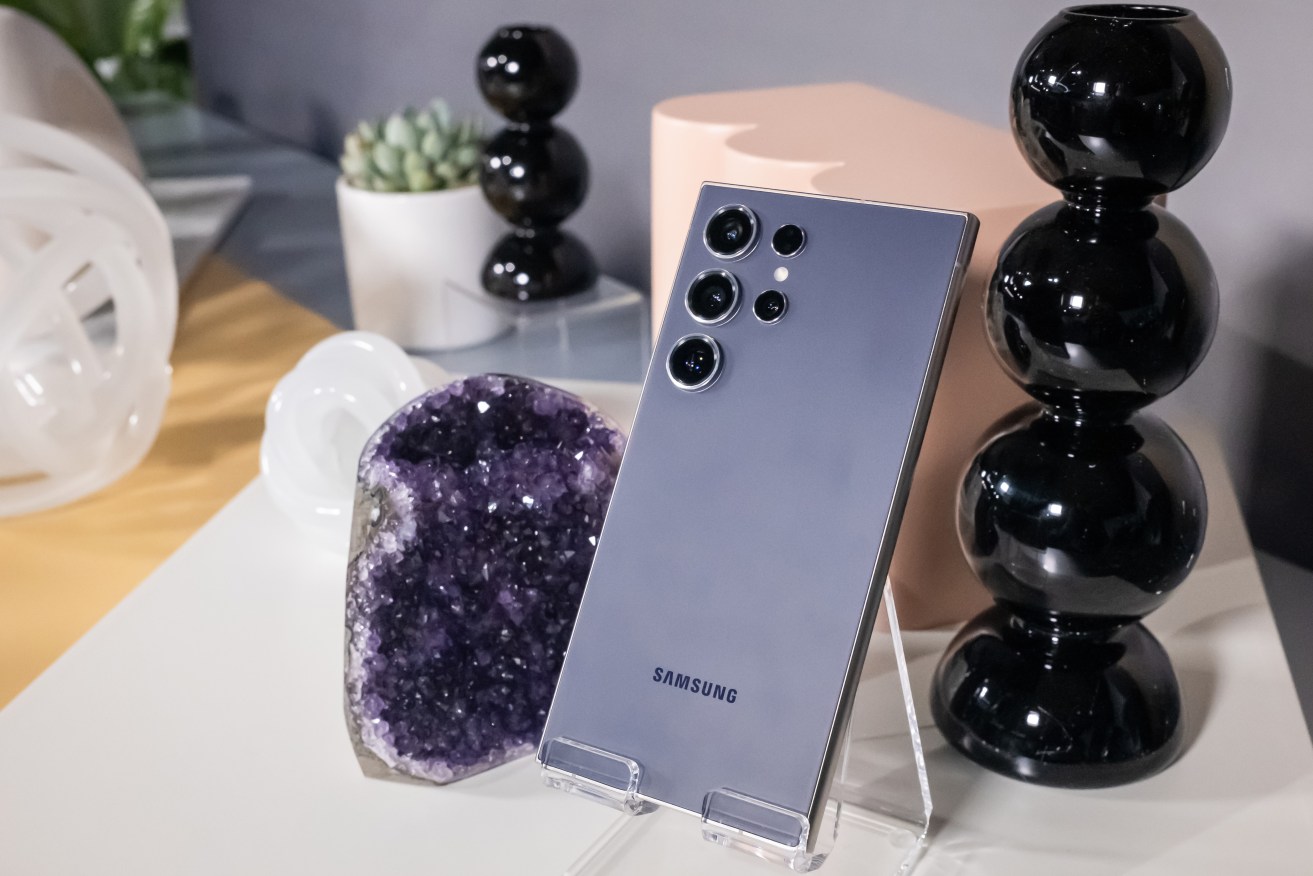After a year ‘s wait, these are the new tricks to expect on AI smartphones
After a year dominating headlines, artificial intelligence is tipped to become the driving force behind next evolution in smartphones – within days.

A display featuring a range of Samsung smartphones with features powered by AI at the Signia by Hilton in San Jose, California, Tuesday, January 16, 2024. (AAP Image/Jennifer Dudley-Nicholson) NO ARCHIVING
Samsung’s upcoming flagship devices, three Galaxy S24 handsets, will be released in Australia on February 7 with a host of features powered by AI in ways consumers have yet to experience.
From image-editing to instant translations, this is what the next generation of smartphone technology promises to deliver.
Images – Generative AI editing software will allow users to move subjects around a photo, enlarge or delete objects and fill in missing parts of a photo’s background using software to fill gaps. Photos edited with AI on Samsung phones will feature a watermark in the left corner and have “modified with generative edit” recorded in the metadata.
Search – In a feature developed with Google, Circle to Search will let users draw a line around any item on the device’s screen to search the web for details about it. The feature can also be used with the phone’s camera to identify landmarks, products, people or businesses.
Translation – AI will be used to translate languages in real-time on calls in Samsung’s new devices. It will recognise 30 languages and announce its use on the phone call before translation begins. A second app, Interpreter, can be used for in-person live translations and will show translated text on the screen.
Messages – In addition to translating foreign languages, AI software will give users suggestions for how to make their text messages appear formal, casual, polite or filled with emoji.
Notes – AI software on the S24 phones will summarise long transcripts or notes and can also be used to provide dot-point summaries of online news stories. The feature will be unavailable on news sites with paywalls, however.
The world’s biggest smartphone maker has unveiled its first handset powered by generative artificial intelligence software, in a move Samsung says will usher in “a new AI era” for the technology.
The South Korean tech giant launched its flagship Galaxy S24 phones at an event in San Jose on Thursday, Australian time, revealing devices with a suite of AI photo-editing, translation and internet search tools.
Industry experts predicted the launch would kick off a trend in AI smartphones but warned consumers would need consistent warnings to show when the technology had been used and ensure they were not misled.
The launch came just one day after the federal government released its Safe and Responsible AI interim report, which outlined plans to develop a voluntary standard to label AI content.
Samsung’s latest smartphones are the first to promote AI tools, which Samsung Australia mobile experience director Eric Chou said showed it felt consumers were ready to embrace the technology.
“We believe this is the new AI era,” he told AAP.
“Everyone’s now quite comfortable with the concept of AI so we’re effectively ramping up the services we offer consumers.”
The three new smartphones, to be released on February 7 and priced from $1399, will feature AI image-editing software allowing users to move or delete subjects and artificially add backgrounds, as well as AI translations for live phone calls, and a new visual Google search feature.
As a safeguard, Mr Chou said the phones would add a watermark and metadata record to digital items created using AI, including edited photos and AI-generated summaries and transcripts.
“The safeguard is pretty clear for us – anything that is edited will have a watermark,” he said.
“Right now it’s not regulated but at some stage it will be so we’ve taken a forward-leaning stance that we do want to ensure anything that is not part of a human interaction is called out.”
University of NSW AI Institute chief scientist Toby Walsh said consumers should expect many more AI-powered smartphones to launch this year as companies seek to catch up to innovation in other parts of the industry.
But he said the development of a standard AI label would be important to help maintain trust in digital photos and videos, though they could be five to 10 years away.
“Digital watermarks are going to become much more important but they are relatively easy to get around now,” he said.
“In the long term, digital watermarks will be built into the hardware of our devices, which is going to make more difficult for people to get around them.”
Digital labels were addressed in the government’s AI report on Wednesday, which named the development of “voluntary labelling and watermarking of AI-generated materials” as one of its immediate priorities.
Tech Council of Australia chief executive Kate Pounder welcomed the development of watermarking standards and said many tech firms were keen to play a role in introducing safeguards.
“There are a number of companies, from Adobe to Google and others, who are already introducing those technologies just as Samsung is doing,” she said.
“It’s good to see government and industry working together to start to formalise how this will work.”












